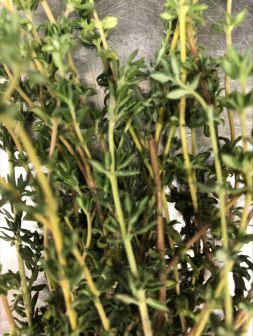Thyme is a perennial herb with almost lanceolate, green, almost hairless leaves that curl downward at the edges. It has small blue flowers with ribbed calyxes. It grows in barren areas throughout Greece and blooms from June to July. It is the plant from which bees produce the most renowned honey. Its use dates back to ancient times. The ancient Egyptians used it as a balsam and aromatic herb, while the ancient Greeks used it as a disinfectant for various diseases. Roman soldiers used to bathe in water scented with thyme to gain vigor and energy. In pharmacology, it is known as the plant with the most therapeutic properties.
Thyme can be used both internally and externally. It is widely used in cooking, where it can be found in meats, salads, sauces, cheeses, soups, grilled dishes, and more. It is also used in pastry making and baking.
It pairs well with oregano, savory, marjoram, rosemary, as well as with olive oil. A characteristic combination is feta cheese with olives, topped with olive oil and sprinkled with thyme.
LATEST RECIPES
GET LATEST UPDATES
Newsletter Subscribe
FEATURED ARTICLE

GET LATEST UPDATES
Newsletter Subscribe























































































